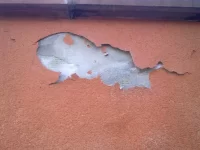JohnDoe
Active Member
Went to look at some internal work for a guy, who then asked me about his external render. He had a thin coat system done 3 1/2 years ago and from what i could see the top coat was coming away from the basecoat, it had been meshed as i could see it. They used Weber.plast TF .... I told him it very unlikely to be able to patch it up, but it old him i will see what i can find out and do.
Thoughts on why top coat would come away? And what can be done?
Thanks
Thoughts on why top coat would come away? And what can be done?
Thanks

